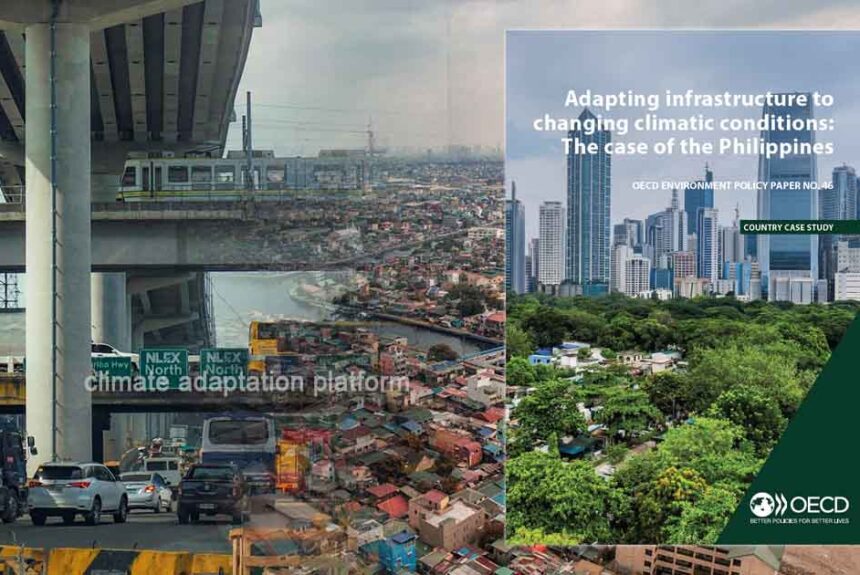Infrastructure fosters rapid growth and alleviates poverty across many emerging Asian nations, including the Philippines. However, as an archipelago, the Philippines encounters distinct challenges that necessitate a modern, interconnected infrastructure network.
The country is currently facing several pressing infrastructure issues. First, there is an immediate demand for adequate, high-quality infrastructure, especially in urban areas, which are among the fastest growing globally. Second, the Philippines needs to tackle the growing impacts of climate change and prioritise constructing resilient infrastructure.
The OECD policy paper presents the findings from a policy dialogue conducted in the Philippines. The dialogue focused on incorporating climate resilience into infrastructure planning and development. The paper provides an overview of current policies and practices and recommendations for the government to enhance infrastructure resilience against climate change and achieve future goals.
Climate change risks
According to the policy paper, the Philippines is increasingly vulnerable to extreme weather events, which have become more frequent and intense over the past few decades and are expected to continue as climate change progresses.
On average, the country experiences about twenty typhoons each year and a range of other climate hazards, including heavy rainfall, floods, landslides, intense heat, droughts, and rising sea levels.
The Philippines has already seen a warming trend, with average temperatures increasing by 0.65°C from 1951 to 2010. Furthermore, sea levels rose by 0.15 metres between 1940 and 2017, a projected trend to continue. By the end of the century, average temperatures could increase by as much as 2.9°C under a high-emission scenario. The likelihood of heat waves is also anticipated to increase by 52-76% under both moderate and high-emission scenarios.
Mindanao, known as the Philippines’ food basket, is projected to face prolonged heat waves as early as 2050, along with a decrease in precipitation of up to 11%. This poses a serious threat to the country’s food supply, security, and overall economy.
Precipitation patterns are expected to become more variable, with increased rainfall in the northern and central regions and a decline in the southern region of Mindanao.
Additionally, high-intensity typhoons are expected to occur more frequently, leading to more significant impacts. Sea levels may rise by up to 0.65 metres by 2100, putting approximately one million Filipinos at risk of coastal flooding.
The need for climate-resilient infrastructure in the Philippines
This policy paper defines climate-resilient infrastructure as carefully planned, designed, built and operated to anticipate, prepare for, and adapt to changing climate conditions. The increasing risks associated with climate change highlight the urgent need to develop infrastructure that can withstand its impacts.
By incorporating climate resilience into their design and operation, infrastructure can better endure, respond to, and recover quickly from climate-related disruptions. This approach ultimately reduces the severity of these events, minimising costly repairs and rehabilitation efforts.
Moreover, investing in climate-resilient infrastructure can yield significant benefits, such as extended asset lifespan, higher returns on investment, and improved reliability and efficiency in service delivery. Therefore, integrating climate resilience is a crucial strategic element in developing and upgrading infrastructure networks in the Philippines.
The new Philippine Development Plan: An opportunity to strengthen climate resilience
The Philippine Development Plan (PDP) acts as the national blueprint and strategic framework for guiding the country’s medium-term economic development. It sets various socio-economic targets, including economic growth, poverty reduction, and infrastructure expansion, to promote the country’s economic and social progress.
Furthermore, the PDP for 2023-2028 highlights the significance of climate resilience and its integration into infrastructure planning.
Progress and challenges
The policy paper details the progress in expanding infrastructure and incorporating climate resilience within the country.
Key progress includes increased policies supporting this integration, enhanced risk assessment capabilities achieved through new national and local government tools, and the establishment of no-build zones. Additionally, updated technical codes have promoted the inclusion of climate resilience in infrastructure design, and specific criteria for significant projects have been established.
However, challenges persist, such as the lack of clear standards for climate-resilient infrastructure, which hinders effective planning. The availability of numerous assessment tools can lead to confusion and slow the adoption and evaluation of the necessary climate adaptation measures. Moreover, the limited technical capacity at all government levels may slow the adoption of the necessary adaptation measures.
The awareness of climate resilience also varies among sectors. For instance, while the water sector mainstreams climate resilience and pursues nature-based solutions, the energy sector focuses on establishing standards.
The ICT sector, primarily driven by private stakeholders, seeks better alignment with national objectives. The transport sector emphasises strategic fund allocation, and the social sector highlights project prioritisation based on risk assessments.
The National Economic and Development Authority (NEDA) oversees socio-economic planning and the Philippine Development Plan (PDP), which sets key infrastructure objectives for the next six years. A flagship project, the Build-Better-More (BBM) programme, aims to invest US$ 243 billion from 2023 to 2028 in critical infrastructure across various sectors, including airports, railways, roads, water resources, and flood control facilities.
The report provides recommendations to support NEDA in guiding the country’s future infrastructure planning, focused on five key strategies:
- Common Guidelines Development: Establish guidelines and a climate-resilient infrastructure label to aid NEDA and practitioners.
- Capacity Building: Implement training programmes for planners and practitioners throughout the infrastructure life cycle.
- Streamlined Assessment Processes: The Infrastructure Committee should integrate climate-resilient criteria in project appraisal and approval.
- Dedicated Agency Creation: Form an independent agency or unit within NEDA to certify climate-resilient infrastructure projects.
- Financing Alignment: Establish clear climate-resilient indicators in the PDP to support budget allocations and incentivise private investments in resilience.
Read the policy paper by clicking the link in the “Source” section below.
Source:
Adapting infrastructure to changing climatic conditions. The case of the Philippines. (25, September 2024). OECD. Retrieved from https://www.oecd.org/en/publications/adapting-infrastructure-to-changing-climatic-conditions_a4c3f35a-en.html



Leave a Reply